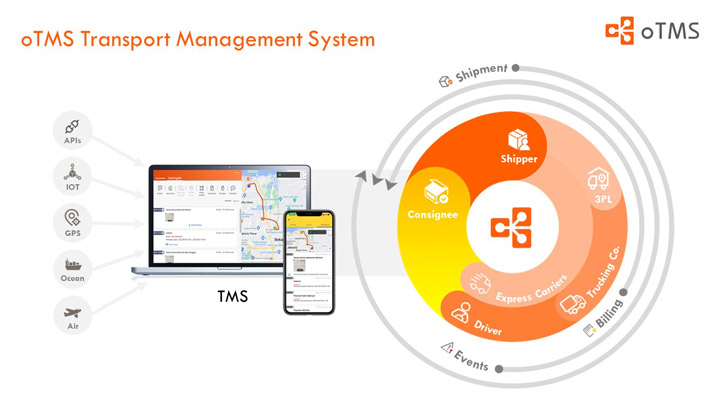Is in-house TMS development better than outsourcing?
 Page views: 3,130 times
Page views: 3,130 times
Nowadays, the digital transformation of enterprises has become a market consensus, and technological capability is one of the most important productivities for enterprise development, especially in the logistics and transportation industry, enterprises attach great importance to the use of digital tools: starting from the earliest use of ERP, and extending to specialties management like TMS. According to the studies of Allied Market Research, almost 35% of the enterprises worldwide are now using TMS for managing their transportation network. With increasing complexities of logistics and transportation, the need for TMS can never be exaggerated.
The ultimate aim of digital transformation is to improve technology and management capabilities, and to achieve overall revenue growth, efficiency improvement as well as cost reduction. Therefore, the method and intensity of investment in digitalization is an important subject that every decision-maker must study. We will talk about these topics in this article: Which one is better, self-developed TMS or outsourced? How to input resources more efficiently?
1. Build a cost structure model from a global perspective
To get the answers to these questions, the decision-makers must deepen their understanding of the nature, composition, and classification of enterprise technology costs. Enterprises need to establish a cost structure model from a global perspective and form business-oriented cost metrics, so as to ensure that cost input can achieve the ultimate aim of digital transformation.
The enterprise technology costs include not only the cost of the technology department, but also the cost of the enterprise’s business department to develop its business through technological capabilities. They could be divided into 2 dimensions, one is explicit cost, which is directly related to technology departments: IT resource cost, labor cost, data cost and cost of funds; the other is implicit cost, which is related to enterprise business: time cost, opportunity cost, trial-and-error cost and sunk cost.
· IT resource cost: The facility cost used by enterprise to support the construction, operation and maintenance of IT systems.
· Labor cost: The human resource cost invested by enterprise around the construction, operation and maintenance of the IT system.
· Data cost: The cost of data collection, analysis and usage by enterprise.
· Cost of funds: The cost paid by enterprise to raise and use funds.
· Opportunity cost: An enterprise uses certain resources to produce one commodity, but loses the cost of using these resources to produce other commodities of the highest value.
· Time cost: The cost of time used by enterprise to engage in an activity.
· Trial-and-error cost: All the costs incurred by enterprise in the process of constantly trying different methods to solve a problem.
· Sunk cost: Costs that have been incurred by enterprise and cannot be recovered.
2. Do not invest strategic resources in non-strategic directions
For enterprises, decision-makers should focus on the key “efficiency factors” such as how to optimize time costs and how to reduce trial-and-error costs, so that they can go straight to “doing the right thing” instead of “doing it in the right way”.
Therefore, the pioneering enterprises in the digital transformation have given the answer between “in-house TMS” and “outsourced TMS”, and they have become top students in digital transformation by choosing outsourced TMS. Now, they have shifted to a more far-reaching strategic stage – refined management.
More and more cloud-based transportation management systems are sold as software-as-a-service (SaaS) due to this trend. This means that users subscribe to the technology on a monthly or annual basis. This is more cost-effective and users are always on the most recent version of the software, which provides opportunities for the overall growth of the market as well.
3. How to input resources to generate income or gain profits
As a pioneer of transport management platform in China, oTMS has won the favor and recognition of many benchmarking companies with its interconnected TMS since its establishment. The pioneering SaaS TMS+APP/mini program+API+IOT model allows enterprises to easily realize the digital management of the whole process and all channels of transportation through oTMS, covering road, express, and multimodal transportation. From order distribution, real-time transport visibility for road, express, air and ocean to digital POD, data analysis, and dock scheduling, the overall logistics management and control capabilities of enterprises have been greatly improved by using the oTMS system.

In this process of digital transformation, the investment of enterprises has been transformed into tangible efficiency improvements and cost reductions. For example, a well-known fast fashion retailer with 7000+ outlets around the world, whose orders are about 1 million/month, eliminated 500,000 pcs of paper through oTMS APP QR Code scanning by POS, achieved paperless store deliveries / returns / transfers. The biggest food company in China with 130 factories and distribution centers achieved 6.7% cost saving of freight cost in first 6 months through advanced ship-from location optimization based on inventory and production schedule. A leading auto parts company with 3000 shipments/month achieved nearly 1.5% cost saving through auto order consolidation and allocation.
In an complex environment, TMS is an important foundation for enterprises to move towards refined and intensive management. Especially for large enterprises with multinational business, increasing the digital transformation of logistics can accumulate more power to improve comprehensive competitiveness. Choosing a professional service provider allows enterprises to focus their energy and resources on the most strategic and core business. As a pioneer in the TMS industry, oTMS will always break through itself, and use advanced technology and perfect products to continuously serve the business of enterprises.









